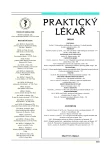Idiopatická makulární díra – epidemiologie, klasifikace, přirozený průběh, terapie
Idiopathic macular hole - epidemiology, classification, natural course, and therapy
Idiopathic macular hole is a relatively frequent event affecting the macular area of the retina. It occurs foremost in elderly females. Prevalence is the greatest in the sixties and seventies of life. The ratio of females to males suffering this affection is three to one. The incidence of this disease is one in 3300 patients at an average. In the initial stages of the disease the idiopathic macular hole is not developed in full depth, and that is called imminent hole. In about half of the patients there comes about a spontaneous regression at the stage of an imminent hole. In the other half the idiopathic macular hole progresses to fenestration in full depth of the retina. In question is mostly a unilateral affection, the risk of development of a macular hole in the other eye is less than 2% when the rear vitreous membrane is ablated. The basic symptoms by which the disease is manifested aedecreased central visual acuity and metamorphopsia (image deformation). Even in the terminal stages of the disease the patients are not threatened by total blindness in the affected eye as long as there is no other pathology present. The method of choice in the treatment of the idiopathic macular hole is pars plana vitrectomy with removal of the posterior hyaloid membrane and with intraocular expansive gas tamponade. With this therapeutic procedure there can be attained a closure of the idiopathic macular hole in more than 90% of the patients.
Key words:
idiopathic macular hole - pas plana vitrectomy - peeling of internal limiting membrane
Autoři:
P. Kolář
Působiště autorů:
Oftalmologická klinika LF MU a FN, Brno
přednostka prof. MUDr. E. Vlková, CSc.
Vyšlo v časopise:
Prakt. Lék. 2005; 85(12): 697-700
Kategorie:
Z různých oborů
Souhrn
Idiopatická makulární díra je poměrně časté onemocnění postihující makulární oblast sítnice. Vyskytuje se především u starších žen. Prevalence je nejvyšší v 6. a 7. deceniu. Ženy vůči mužům jsou postiženy v poměru 3 : 1. Incidence onemocnění je udávána v průměru 1/3300 pacientů. V počátečních stadiích onemocnění není vyvinuta idiopatická makulární díra v plné tloušťce a hovoříme o hrozící díře. Asi u poloviny nemocných dochází ve stadiu hrozící díry ke spontánní regresi. U další poloviny nemocných idiopatická makulární díra progreduje do fenestrace v plné tloušťce sítnice. Jde většinou o jednostranné onemocnění, riziko vývoje makulární díry v druhém oku, pokud je přítomna ablace zadní sklivcové membrány, je menší než 2 %. Základními symptomy, kterými se onemocnění projevuje, jsou pokles centrální zrakové ostrosti a metamorfopsie (deformace obrazu). Ani v terminálních stadiích onemocnění nehrozí pacientům úplné oslepnutí postiženého oka, pokud není přítomna jiná patologie. Metodou volby v léčbě idiopatické makulární díry je pars plana vitrektomie s odstraněním zadní sklivcové membrány a nitrooční tamponádou expanzivním plynem. S použitím tohoto terapeutického postupu je možné dosáhnout uzavření idiopatické makulární díry u více než 90 % pacientů.
Klíčová slova:
idiopatická makulární díra – pars plana vitrektomie – peeling vnitřní limitující membrány.
Štítky
Praktické lékařství pro děti a dorost Praktické lékařství pro dospěléČlánek vyšel v časopise
Praktický lékař

2005 Číslo 12
- Není statin jako statin aneb praktický přehled rozdílů jednotlivých molekul
- Isoprinosin je bezpečný a účinný v léčbě pacientů s akutní respirační virovou infekcí
- Metamizol jako analgetikum první volby: kdy, pro koho, jak a proč?
- Mirtazapin v léčbě deprese spojené s nadměrným užíváním alkoholu
- Horní limit denní dávky vitaminu D: Jaké množství je ještě bezpečné?
Nejčtenější v tomto čísle
- Malabsorpční syndrom u dětí, diagnostika a léčba
- Idiopatická makulární díra – epidemiologie, klasifikace, přirozený průběh, terapie
- Hypoxie mozku
- Port a jeho úloha v léčbě onkologicky nemocných
